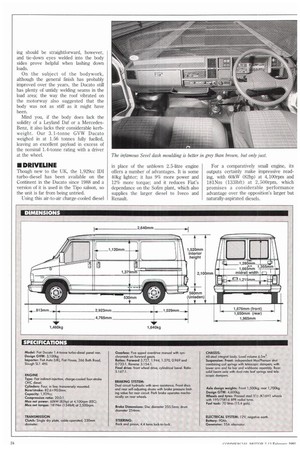ROADTEST FIAT DUCAT
Page 31

Page 32

If you've noticed an error in this article please click here to report it so we can fix it.
The revised Fiat Ducato is not the all-new van we had hoped for, but its undoubted practicality and a powerful new engine make it a good-value contender.
IN With all the arguments over European unification currently raging among the beaurocrats of the member states, it is perhaps surprising that their collective brainpower has not been directed towards finding a common Euroname for the good old panel van.
In the UK, and no doubt much to the Ford bean-counters' delight, the term 'Transit' has become synonymous with all such slab-sided load carriers, and our own pin-striped negotiators could surely put a strong case for its pan-European adoption.
The re-unified Germans, on the other hand, would also undoubtedly form a powerful pro-Transporter' lobby, but with national pride at stake, the most powerful opposition could well come from a FrancoItalian alliance based on the PSA/Fiat Sevel van project.
But which name would they adopt? Fiat would suggest the Ducato and Citroen the C25, while Peugeot would have to decide between the j5 label used on the Continent and the (Talbot) Express title chosen here.
Unlikely as it is, this hypothetical situation does serve to illustrate the identity crisis which afflicts the Sevel vans in the UK, and that in its turn serves to dilute what could be a powerful threat to the Transit's dominant position.
The opportunity to take a fresh look at the Sevel product comes at a time when Fiat, Peugeot (Talbot) and Citroen are on the verge of launching facelifted ranges with the first significant sheet metal changes since the vans went on sale over here in 1982.
Although modifications beneath the skin are a little harder to find, our first full roadtest is of a Fiat Ducato, which boasts the only new engine to be offered by the three importers — a 1.9-litre chargecooled turbo-diesel.
The new turbo slots into the middle of the Ducato line-up, which now offers SWB panel vans with 1.0 and 1.4-tonne payloads; a LWB Maxi van with a 1.8tonne capacity; SWB and LWB chassiscabs, and the 4x4 panel van at 1.2 tonnes.
Every model except the 4x4 has the choice of a 2.0-litre petrol or a diesel, with the 1.9 turbo-diesel taking over from a naturally aspirated 2.5-litre engine in the SWB chassis-cab and the 1.4-tonne van which we test here.
• BODYWORK
With an eye to minimising re-tooling costs, sheet metal changes on the Ducato are understandably confined to the front end of the vehicle, and even then clever use of existing panels like the bonnet has allowed Fiat to achieve maximum impact for minimum outlay.
A fashionable slope has been added to the side windows. When combined with the remodelled wings and slimmer grille the overall effect is pleasingly modern and achieves the purpose of distancing the latest model from its predecessor with some style.
Corrosion protection on the whole body shell has been increased, with 40% of panels by weight now being galvanised on one or both sides, equating to 70% of the total surface area.
With its transverse-engine/front-wheeldrive layout the Ducato has always offered good space utilisation, and this practicality is still a feature of the current versions. To improve access from the side the sliding-door mechanism has been modified to increase the maximum opening; at 1,120mm it compares very well with the competition. Decent sized handles allow the door to be opened or shut with one hand.
Twin rear doors conceal a nice square opening with the bumper acting as a convenient step to climb aboard, and the loading height is a decent 560mm unladen. Metal stays locate the doors at 900, but once open to 180° they are free to flap around, to the possible detriment of the paintwork or passers-by.
Buyers of the 1.4-tonne Ducato will presumably value payload above load volume, so features like the comparatively large wheelarch intrusions are unlikely to worry them, though the feeble interior ighting might. Installing panelling or rack ing should be straightforward, however, and tie-down eyes welded into the body sides prove helpful when lashing down loads.
On the subject of the bodywork, although the general finish has probably improved over the years, the Ducato still has plenty of untidy welding seams in the load area; the way the roof vibrated on the motorway also suggested that the body was not as stiff as it might have been.
Mind you, if the body does lack the solidity of a Leyland Daf or a MercedesBenz, it also lacks their considerable kerbweight. Our 3.1-tonne GVW Ducato weighed in at 1.56 tonnes fully fuelled, leaving an excellent payload in excess of the nominal 1.4-tonne rating with a driver at the wheel.
• DRIVELINE
Though new to the UK, the 1,929cc IDI turbo-diesel has been available on the Continent in the Ducato since 1988 and a version of it is used in the Tipo saloon, so the unit is far from being untried.
Using this air-to-air charge-cooled diesel in place of the unblown 2.5-litre engine offers a number of advantages. It is some 40kg lighter; it has 9% more power and 12% more torque; and it reduces Fiat's dependance on the Sofim plant, which also supplies the larger diesel to Nem and Renault. For a comparatively small engine, its outputs certainly make impressive reading, with 60kW (82hp) at 4,100rpm and 181Nm (133113ft) at 2,500rpm, which promises a considerable performance advantage over the opposition's larger but naturally-aspirated diesels.




















































































































